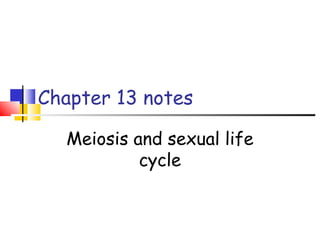Recommended
Recommended
More Related Content
What's hot
What's hot (20)
Similar to Chapter 13
Similar to Chapter 13 (20)
Meiosis, inheritance and variationThe uniqueness and similarities.pdf

Meiosis, inheritance and variationThe uniqueness and similarities.pdf
More from ktanaka2
More from ktanaka2 (20)
Recently uploaded
Recently uploaded (20)
Vector Search -An Introduction in Oracle Database 23ai.pptx

Vector Search -An Introduction in Oracle Database 23ai.pptx
CNIC Information System with Pakdata Cf In Pakistan

CNIC Information System with Pakdata Cf In Pakistan
Connector Corner: Accelerate revenue generation using UiPath API-centric busi...

Connector Corner: Accelerate revenue generation using UiPath API-centric busi...
Navigating the Deluge_ Dubai Floods and the Resilience of Dubai International...

Navigating the Deluge_ Dubai Floods and the Resilience of Dubai International...
Biography Of Angeliki Cooney | Senior Vice President Life Sciences | Albany, ...

Biography Of Angeliki Cooney | Senior Vice President Life Sciences | Albany, ...
WSO2's API Vision: Unifying Control, Empowering Developers

WSO2's API Vision: Unifying Control, Empowering Developers
Web Form Automation for Bonterra Impact Management (fka Social Solutions Apri...

Web Form Automation for Bonterra Impact Management (fka Social Solutions Apri...
Introduction to Multilingual Retrieval Augmented Generation (RAG)

Introduction to Multilingual Retrieval Augmented Generation (RAG)
Repurposing LNG terminals for Hydrogen Ammonia: Feasibility and Cost Saving

Repurposing LNG terminals for Hydrogen Ammonia: Feasibility and Cost Saving
TrustArc Webinar - Unlock the Power of AI-Driven Data Discovery

TrustArc Webinar - Unlock the Power of AI-Driven Data Discovery
Apidays New York 2024 - Scaling API-first by Ian Reasor and Radu Cotescu, Adobe

Apidays New York 2024 - Scaling API-first by Ian Reasor and Radu Cotescu, Adobe
DEV meet-up UiPath Document Understanding May 7 2024 Amsterdam

DEV meet-up UiPath Document Understanding May 7 2024 Amsterdam
ProductAnonymous-April2024-WinProductDiscovery-MelissaKlemke

ProductAnonymous-April2024-WinProductDiscovery-MelissaKlemke
Finding Java's Hidden Performance Traps @ DevoxxUK 2024

Finding Java's Hidden Performance Traps @ DevoxxUK 2024
Elevate Developer Efficiency & build GenAI Application with Amazon Q

Elevate Developer Efficiency & build GenAI Application with Amazon Q
Apidays New York 2024 - APIs in 2030: The Risk of Technological Sleepwalk by ...

Apidays New York 2024 - APIs in 2030: The Risk of Technological Sleepwalk by ...
Chapter 13
- 1. Chapter 13 notes Meiosis and sexual life cycle
- 2. An Introduction to Heredity Heredity: the transition of traits from one generation to the next Along w/ similarities, there is also variation- offspring differ somewhat in appearance from parents to offspring Genetics: the study of heredity and hereditary variation
- 3. An Introduction to Heredity Parents pass information to offspring through coded hereditary units called genes. - 30 to 40 thousand genes in humans - genes are segments of DNA
- 4. Concept 13.1 Two types of reproduction: Asexual reproduction: single parent passes copies of all its genes to offspring; “like begets like.” Sexual reproduction: two parents give rise to offspring; results in greater variation
- 5. Concept 13.2 Life cycle: generation-to-generation sequence of stages in the reproductive history of an organism The human life cycle - each somatic cell has 46 chromosomes (23 pair); 2 copies of each pair are called homologous chromosomes
- 6. Concept 13.2 - chromosomes can be displayed through a karyotype - pairs 1-22 are called autosomes - pair 23 are called sex chromosomes - XX = female; XY = male - we inherit one chromosome of each pair from each parent
- 7. Concept 13.2
- 8. Concept 13.2
- 9. Concept 13.2 - gametes, or sex cells, contain 22 autosomes and 1 sex chromosome; a cell with a single chromosome set is called a haploid cell. - haploid cells are abbreviated 1n (n = 23) - the combining of gametes forms a zygote; becomes a diploid cell (2n)
- 10. Concept 13.2 - The only cells of the human body not produced by mitosis are gametes - this process is a form of cellular division called meiosis; meiosis reduces the chromosome number in half
- 11. Concept 13.2 The variety of sexual life cycles Animal cells - after meiosis, the gametes undergoes no division before fertilization Fungi - after meiosis, mitosis occurs and produces a 1n multicellular organism; forms 1n gametes that then fertilize
- 12. Concept 13.2 Plants (alternation of generations) - has both diploid (sporophyte) and haploid (gametophyte) multicellular stages;
- 13. Concept 13.2
- 14. Concept 13.3 Meiosis, like mitosis, is preceded by the replication of chromosomes; however, the single replication is followed by 2 consecutive divisions (meiosis I and meiosis II)
- 15. Concept 13.3
- 16. Concept 13.3 Meiosis I - during prophase I, chromosomes pair up in synapsis; 4 chromatids form a tetrad - during metaphase I, homologous pairs line up on equator - during anaphase I, chromosomes, not chromatids, separate to poles
- 17. Concept 13.3 Meiosis II - goes through the same steps as meiosis I, but does not replicate DNA Meiosis outcome is 4 1n gametes from a single cell
- 18. Concept 13.4 3 mechanisms contribute to the genetic variation arising from sexual reproduction Independent assortment of chromosomes -each homologous pair of chromosomes is positioned independently of the others; variation is 223 or about 8 million
- 19. Concept 13.4
- 20. Concept 13.4 Crossing over - when chromosomes line up along the equator, parts of chromatids can combine genes from parents Random fertilization - even w/out considering crossing over, any two parents will produce a zygote with any of 70 trillion combination (223 x 223 )
- 21. Concept 13.4
